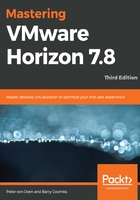
Which protocol should you use – Blast Extreme, PCoIP, or RDP?
Now that we have a good understanding of PCoIP, Blast Extreme, and RDP, which one would you choose?
The most compelling reason to go with PCoIP is the fact that it uses the UDP protocol, which is much better suited to streaming media and therefore lends itself perfectly to the characteristics of virtual desktop delivery, but, as discussed, Blast can also use UDP as the delivery protocol. Just to highlight this again, UDP is not concerned with how the data ends up on the endpoint device; it's only concerned with the speed of delivery and how quickly it gets there.
On the other hand, RDP uses TCP as its protocol, which is widely used across the internet. The key difference with TCP is that it is concerned with how the data is being received. TCP requests an acknowledgment from the endpoint device as to whether it has received all of the packets successfully. If the endpoint device does not receive what it was expecting, then it replies, asking TCP to either stop sending packets or to narrow the amount that it receives. UDP just keeps sending and is much speedier, simply because there is no acknowledgment packet back from the endpoint device.
This is where Blast Extreme would come in, as it can use either TCP or UDP as the delivery protocol and is able to determine what network capacity it has available to it and adjust accordingly.
Blast Extreme will also use fewer resources on the endpoint device, especially if you offload the decoding using the NVIDIA GRID technology. However, the only point to be aware of is that when using TCP as the delivery protocol, it could potentially consume more bandwidth, as it compensates for packet loss.
There are some cases where PCoIP won't be the appropriate protocol and Blast Extreme or RDP would need to be used. The one we see most often is when the required network ports are being blocked by corporate policy, or from remote locations that lock down internet connections.
When your desktop is displayed back to you, PCoIP uses UDP port 4172 to send the pixels. This port is sometimes blocked, as it's not typically used. The result of this port being blocked is that, even though you will be able to log on to your virtual desktop via the View client and everything looks OK' you will just receive a black screen. The black screen is due to the pixels being blocked as they are sent. In this example, the workaround is to access the desktop from an HTML5-enabled browser using Blast Extreme, which uses standard HTTPS ports. We will cover this in Chapter 10, Fine-Tuning the End User Experience.
The key takeaway here is to engage with your networking and security teams when planning how users connect to their virtual desktop machines and look at how the users are working and from what locations. It may well be that you don't need external access, and therefore WAN limitations are no longer a consideration.
Now that we have talked about how to deliver graphics via the delivery protocol, in the next section, we are going to look at the options for enabling high-end graphics in virtual desktop machines.